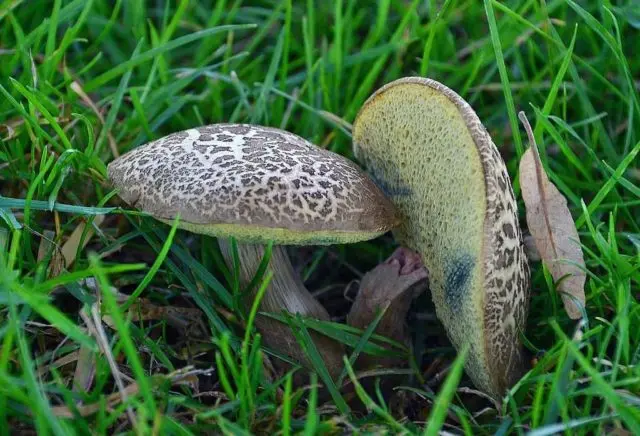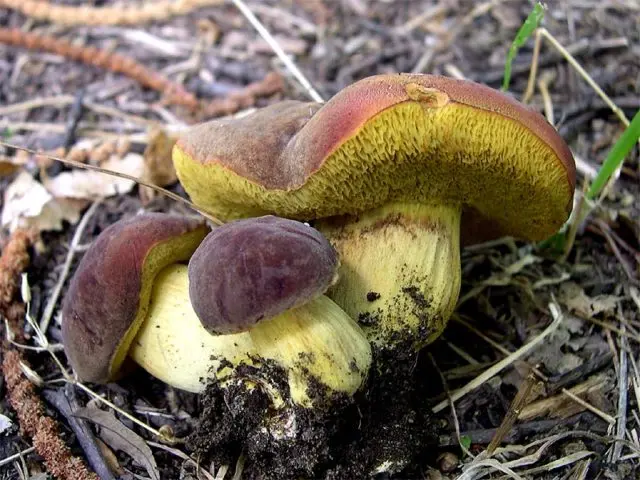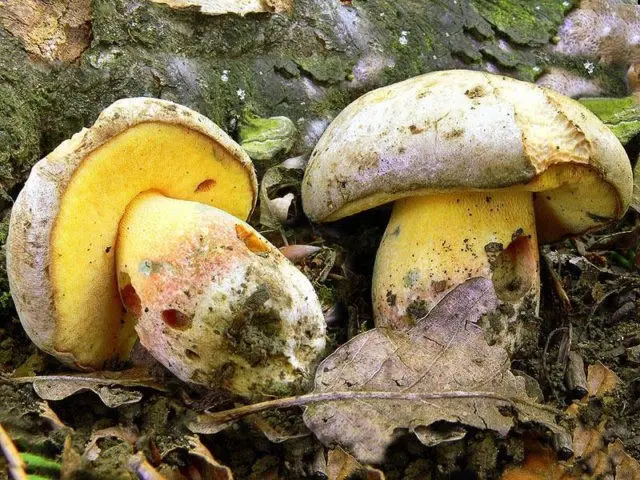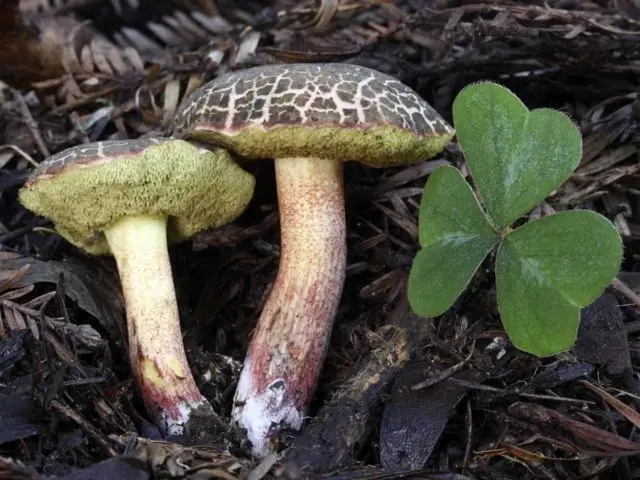Contents
Porosporous boletus is a fairly common tubular fungus belonging to the Boletaceae family of the Mohovichok genus. Refers to edible species with high nutritional value.
What do porosporous mushrooms look like
The cap is convex, has a hemispherical shape, reaches 8 cm in diameter. In adult mushrooms, its edges are often uneven. Color – grayish brown or dark brown. The burst skin forms a network of white cracks on the surface.
The stem is 10 cm long and 2-3 cm in diameter. It is light brown or yellowish at the top, gray-brown or brown at the base. The shape is cylindrical or expanding downwards.
The layer of tubules is lemon-yellow, darkens with growth and acquires a greenish tint, turns blue when pressed. Spores are smooth, fusiform, large. The powder is olive brown or dirty olive.
The pulp is whitish or whitish-yellow, thick, dense, turning blue on the cut. It has no distinct odor or taste.

Where do porosporous mushrooms grow
Distributed in European territory. Habitats – mixed, coniferous and deciduous forests. Grows on moss and grass. Forms a mushroom root with oak.
Is it possible to eat porospore mushrooms
The mushroom is edible. It belongs to the first taste category, valued for its fleshy dense pulp.
False doubles
The porosporous boletus has quite a few similar species, but almost all of them are edible. Only the beautiful boletus is poisonous, but it does not grow in Our Country. It has a large size. The cap diameter is from 7 to 25 cm, the shape is hemispherical, woolly, the color is from reddish to olive-brown. The leg is reddish-brown, covered with a dark mesh below. Its height is from 7 to 15 cm, thickness – up to 10 cm. The flesh is dense, yellow, turns blue on the break. The mushroom belongs to inedible poisonous species, causes poisoning with gastrointestinal upset, there is no information about deaths. Grows in mixed forests. Distributed along the west coast of North America.

Flywheel velvet or waxy. The surface of the cap is without cracks, velvety, with a coating resembling frost. Diameter – from 4 to 12 cm, shape from spherical to almost flat. Color brownish, reddish brown, purplish brown, rich brown. In mature, faded with a pinkish tint. The flesh on the break turns blue. The leg is smooth, in height – from 4 to 12 cm, in thickness from 0,5 to 2 cm. The color is from yellowish to reddish-yellow. It occurs in deciduous forests, prefers the neighborhood of oaks and beeches, in coniferous forests – next to pines and spruces, as well as in mixed ones. It bears fruit at the end of summer and the first half of autumn, grows more often in groups. Edible, has high taste qualities.

Boletus is yellow. The diameter of the cap is from 5 to 12 cm, sometimes up to 20, the surface has no cracks, the skin is usually smooth, sometimes slightly wrinkled, yellowish-brown. The shape is convex, hemispherical, becoming flat with age. The pulp is dense, has a bright yellow color, has no smell, turns blue on the cut. The height of the stem is from 4 to 12 cm, the thickness is from 2,5 to 6 cm. The shape is tuberous, thick. Brownish granulation or small scales can sometimes be seen on the surface. Distributed in Western Europe, in broad-leaved forests (oak and beech). In Our Country, it grows in the Ussuri region. Fruiting from July to October. Edible, belongs to the second taste category.

The flywheel is cracked. The hat is fleshy, thick, dry, like felt. First in the form of a hemisphere, then becomes almost flat. Color – from light brown to brown. Along the edge, you can sometimes see a narrow purple stripe. Reaches 10 cm in diameter. Cracks on the surface revealing reddish flesh. Features upturned edges. The leg is even, cylindrical, has a length of 8-9 cm, a thickness of up to 1,5 cm. Its color at the cap is yellowish-brown, the rest is red. The spore-bearing layer is yellow, with the growth of the fungus it first turns gray, then acquires an olive hue. The flesh turns blue on the cut. It occurs quite often throughout Our Country with a temperate climate. Grows in deciduous forests from July to October. Edible, belongs to the fourth category.

Collection rules
The fruiting time of the porosporous boletus is summer and autumn. The most active growth is observed from June to September.
They are able to absorb heavy metal salts, carcinogens, radioactive and other substances hazardous to health, which can also be found in car exhaust gases, from soil, rainwater and air.
Use
Porosporous mushrooms are suitable for any processing methods. They are fried, stewed, salted, marinated, dried.
Before cooking, they need to soak for 5 minutes, then drain the water. Chop large ones, leave small ones whole. They are brought to a boil, reduce the heat and cook for 10 minutes, periodically remove the foam. Next, change the water and cook for another 20 minutes. The mushrooms are ready when they have sunk to the bottom.
Conclusion
Porosporous boletus is a high-quality edible mushroom that belongs to valuable species. It is often confused with cracked, which can be eaten, but its taste properties are much lower.









